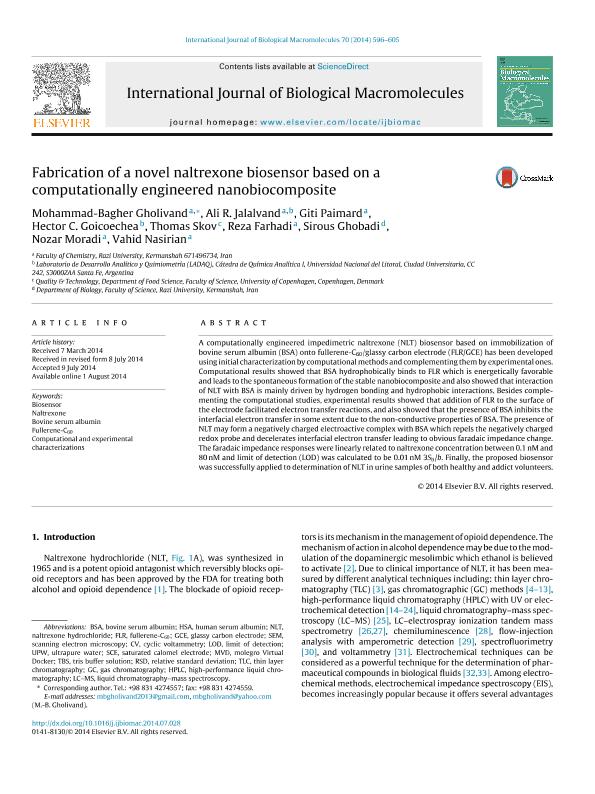Mostrar el registro sencillo del ítem
dc.contributor.author
Gholivand, Mohammad Bagher

dc.contributor.author
Jalalvand, Ali R.

dc.contributor.author
Paimard, Giti

dc.contributor.author
Goicoechea, Hector Casimiro

dc.contributor.author
Skov, Thomas

dc.contributor.author
Farhadi, Reza

dc.contributor.author
Ghobadi, Sirous

dc.contributor.author
Moradi, Nozar

dc.contributor.author
Nasirian, Vahid

dc.date.available
2017-05-05T18:04:43Z
dc.date.issued
2014-09
dc.identifier.citation
Gholivand, Mohammad Bagher; Jalalvand, Ali R.; Paimard, Giti; Goicoechea, Hector Casimiro; Skov, Thomas; et al.; Fabrication of a novel naltrexone biosensor based on a computationally engineered nanobiocomposite; Elsevier Science; International Journal of Biological Macromolecules; 70; 9-2014; 596-605
dc.identifier.issn
0141-8130
dc.identifier.uri
http://hdl.handle.net/11336/16035
dc.description.abstract
A computationally engineered impedimetric naltrexone (NLT) biosensor based on immobilization of bovine serum albumin (BSA) onto fullerene-C60/glassy carbon electrode (FLR/GCE) has been developed using initial characterization by computational methods and complementing them by experimental ones. Computational results showed that BSA hydrophobically binds to FLR which is energetically favorable and leads to the spontaneous formation of the stable nanobiocomposite and also showed that interaction of NLT with BSA is mainly driven by hydrogen bonding and hydrophobic interactions. Besides complementing the computational studies, experimental results showed that addition of FLR to the surface of the electrode facilitated electron transfer reactions, and also showed that the presence of BSA inhibits the interfacial electron transfer in some extent due to the nonconductive properties of BSA. The presence of NLT may form a negatively charged electroactive complex with BSA which repels the negatively charged redox probe and decelerates interfacial electron transfer leading to obvious faradaic impedance change. The faradaic impedance responses were linearly related to naltrexone concentration between 0.1 nM and 80 nM and limit of detection (LOD) was calculated to be 0.01 nM (3Sb/b). Finally, the proposed biosensor was successfully applied to determination of NLT in urine samples of both healthy and addict volunteers.
dc.format
application/pdf
dc.language.iso
eng
dc.publisher
Elsevier Science

dc.rights
info:eu-repo/semantics/openAccess
dc.rights.uri
https://creativecommons.org/licenses/by-nc-nd/2.5/ar/
dc.subject
Biosensor
dc.subject
Bovine Serum Albumin
dc.subject
Naltrexone
dc.subject
Fullerene-C60
dc.subject
Computational And Experimental Characterizations
dc.subject.classification
Química Analítica

dc.subject.classification
Ciencias Químicas

dc.subject.classification
CIENCIAS NATURALES Y EXACTAS

dc.title
Fabrication of a novel naltrexone biosensor based on a computationally engineered nanobiocomposite
dc.type
info:eu-repo/semantics/article
dc.type
info:ar-repo/semantics/artículo
dc.type
info:eu-repo/semantics/publishedVersion
dc.date.updated
2017-04-17T19:26:47Z
dc.journal.volume
70
dc.journal.pagination
596-605
dc.journal.pais
Países Bajos

dc.journal.ciudad
Ámsterdam
dc.description.fil
Fil: Gholivand, Mohammad Bagher. Razi University. Faculty of Chemistry; Irán
dc.description.fil
Fil: Jalalvand, Ali R.. Razi University. Faculty of Chemistry; Irán. Universidad Nacional del Litoral; Argentina
dc.description.fil
Fil: Paimard, Giti. Razi University. Faculty of Chemistry; Irán
dc.description.fil
Fil: Goicoechea, Hector Casimiro. Universidad Nacional del Litoral; Argentina
dc.description.fil
Fil: Skov, Thomas. Universidad de Copenhagen; Dinamarca
dc.description.fil
Fil: Farhadi, Reza. Razi University. Faculty of Chemistry; Irán
dc.description.fil
Fil: Ghobadi, Sirous. Razi University. Faculty of Science. Department of Biology; Irán
dc.description.fil
Fil: Moradi, Nozar. Razi University. Faculty of Chemistry; Irán
dc.description.fil
Fil: Nasirian, Vahid. Razi University. Faculty of Chemistry; Irán
dc.journal.title
International Journal of Biological Macromolecules

dc.relation.alternativeid
info:eu-repo/semantics/altIdentifier/doi/http://dx.doi.org/10.1016/j.ijbiomac.2014.07.028
dc.relation.alternativeid
info:eu-repo/semantics/altIdentifier/url/http://www.sciencedirect.com/science/article/pii/S0141813014005030
Archivos asociados
